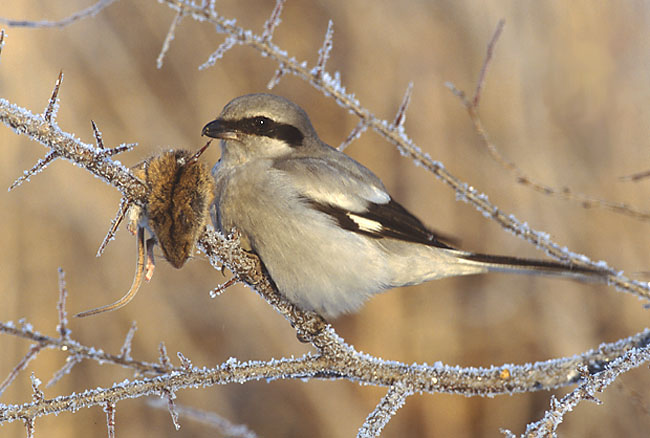|
Great Grey Shrike (Lanius excubitor) - Wiki
| 제목: | Great Grey Shrike (Lanius excubitor) - Wiki
| |

| 해상도: 650x438
파일크기: 71359 Bytes
등록시간: 2007:01:10 21:31:20
|
ERROR : Server Busy(-1105)
ERROR : Server Busy(-1105)
Great Grey Shrike (Lanius excubitor) - Wiki
Great Grey Shrike
From Wikipedia, the free encyclopedia
[Photo] Lanius excubitor. Author: Marek Szczepanek http://commons.wikimedia.org/wiki/User:Pkuczynski/Marek_Szczepanek
The Great Grey Shrike (Lanius excubitor) is a member of the shrike family.
The Great Grey Shrike breeds in northern Europe, Asia and in North America in northern Canada and Alaska, where it known as Northern Shrike. It is migratory and winters further south in those continents, too, for example, Great Britain and the northern USA. Wintering birds usually arrive in October and November. As a rule they are then solitary, and when several arrive simultaneously they speedily spread out, each establishing its hunting territory and reducing competition with others.
The Southern Grey Shrike (Lanius meridionalis), occurring from southern Europe (Iberian Peninsula and France) southwards and also in Central Asia, was formerly included in the Great Grey Shrike; it prefers different habitat (lightly wooded grassland in the Great Grey, more arid shrubland in the Southern Grey Shrike), and where the species' ranges overlap, they do not hybridize (Sangster et al., 2002).
The Great Grey Shrike is 22-26 cm long. The general colour of its upper parts is pearl grey; a stripe above the eye and the cheeks and chin are white, and a deep black streak extends from the forehead, through the eye, to the ear coverts. The scapulars are white and the wings black and white, with one or two white bars. The under parts are white, slightly tinged with grey. The bill is nearly black, pale at the base of the under mandible; the legs are blackish.
In the female the under parts are greyer, and are faintly barred with greyish brown. Young birds are greyish brown, with more or less distinct bars on the upper, and conspicuous ones on the under parts.
This bird has a characteristic upright attitude perched on the topmost branch of a tree or a telegraph pole. The keen eye of the watchful "sentinel" misses nothing that moves. It will swoop hawk-like on a bee or drop lightly to the grass for an insect.
Though it uses its feet to hold beetles or flies, it has other methods with larger prey such as lizards, mice, shrews and birds. These when captured are impaled upon a sharp point, such as a thorn or the barbs of barbed wire. Thus secured they can be ripped with the strong hooked bill, but its feet are not suited for tearing. Typically, half the prey consists of small mammals.
The flight of the Great Grey Shrike is undulating but rather heavy, but its dash is straight and determined.
When disturbed its alarm note is a harsh jay-like skake, skake. The song consists of pleasant warbling. This species will lure birds closer by mimicking their calls.
http://en.wikipedia.org/wiki/Great_Grey_Shrike
| The text in this page is based on the copyrighted Wikipedia article shown in above URL. It is used under the GNU Free Documentation License. You may redistribute it, verbatim or modified, providing that you comply with the terms of the GFDL. |
|
댓글 |
|---|
| | 손님 |
|
Scientific Name: Lanius excubitor Linnaeus, 1758
Common Names: Great Grey Shrike, Grey Shrike, Northern Shrike (borealis, invictus), North Siberian Shrike (sibiricus), Steppe Shrike (homeyeri), Altai Shrike (mollis)
French: Pie-grièche grise German: Raubwürger Spanish: Alcaudón Norteño
Taxonomy: Lanius excubitor Linnaeus, 1758, Europe = Sweden. |
^o^
동물그림창고 똑똑전화 누리집
^o^
|
|
|